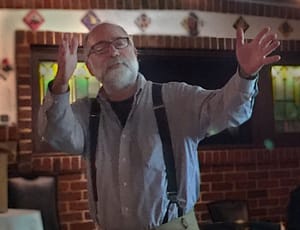 The Burroughs Creek Trail in East Lawrence is a paved path and parkway running for 1.7 miles from 11th Street at the north end to 23rd Street on the south. The trail leads walkers, runners, and bikers past sites that were significant in Lawrence history, blending both health and history for all who travel its length.
The Burroughs Creek Trail in East Lawrence is a paved path and parkway running for 1.7 miles from 11th Street at the north end to 23rd Street on the south. The trail leads walkers, runners, and bikers past sites that were significant in Lawrence history, blending both health and history for all who travel its length.
In a presentation to Lawrence Central Rotarians, Henry Fortunato explained the variety of historic places found along to the Burroughs Creek Trail. The path “ties together William Clarke Quantrill, and Langston Hughes, 19th-century travelers on the Oregon Trail and World War II-era German prisoners of war, the artistry of William S. Burroughs and the agricultural history of Douglas County, plus a long-forgotten railroad line and a number of dimly-remembered east side neighborhood notables whose names still grace streets and parks,” to quote the Lawrence Public Library website.
Fortunato, retired director of public affairs at the Kansas City Library and recent Simons Public Humanities Fellow at the Hall Center for the Humanities at the University of Kansas, made headlines in 2014 for walking 500 miles across Kansas. He said in interviews at the time that he wanted to “take the love for walking and exploring and create something everyone can enjoy.” He envisioned combining “all the things he’s learned in his professional career — public history, presentation, use of graduate students, humanities, and traveling exhibits — to enhance the walking and hiking trail experience in the greater Kansas City area by creating well designed interpretive panels” that tell about what happened along those trails. Happily, Lawrence has become the beneficiary of Fortunato’s vision.
Fortunato’s comments referenced the traveling exhibit of ten panels that tell the stories of people, places, and events associated with the trail. The exhibit is currently hosted at Watkins Museum of History. By next spring, the panels of the traveling exhibit will be translated into interpretive signage along the Burroughs Creek Trail itself that will explain the points of interest and the history of area to people as they travel the length of the path.